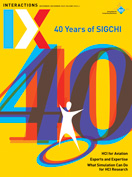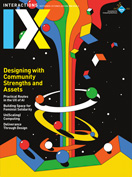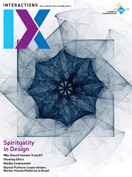Authors:
Teresa O'Leary, Elizabeth Stowell, Darley Sackitey, Hye Yun, David Wright, Michael Paasche-Orlow, Timothy Bickmore, Andrea Parker
For many, spirituality is a core value. Recognizing the centrality of spirituality to the human experience and its intersection with other values such as health, public health research has a long tradition of developing faith-based health interventions. These programs have a combined focus on spirituality and health promotion, and are a vital tool for amplifying the well-being of communities generally and addressing health inequities specifically [1]. In particular, many faith-based interventions have focused on the Black church, a term we use to refer to the seven primary Christian denominations that serve Black populations.
→ Health, community, and spirituality are deeply interrelated for faith communities, and this should shape the design of health interventions for these communities.
→ The integration of spiritual dimensions into health technologies is not a one-size-fits-all pursuit—every religious denomination and every church has its own unique culture—so community participation is key to tailoring these interventions.
Black Americans disproportionately experience chronic diseases, including heart disease, hypertension, and diabetes, and significantly higher rates of hospitalization and mortality compared with white Americans [1]. Many historically Black churches are dedicated to addressing such inequities through health ministry programming and activism. As trusted sources of leadership, these churches serve the interests of both their congregants and the local community through their coordination of community health initiatives [1,2]. While their focus is on spiritual growth and well-being, building community and facilitating social support are also core aims. In addition to the sermons, songs, and other aspects of the worship service, members attend church to connect to their church family (a term of endearment that members use to refer to other members). These attributes make churches a compelling site for disseminating community-based health interventions for Black communities [1,2].
Despite explosive innovation within the digital health space and the proliferation of mobile health (mHealth) apps, designers and researchers have almost entirely ignored how to support well-being when designing health technologies for religious communities. To address this gap, we embarked on a multiyear community-engaged effort to develop an mHealth intervention with and for historically Black church communities. This collaborative effort began in 2019 and has continued throughout the Covid-19 pandemic. We began by investigating how an mHealth intervention can support wellness behaviors in the church community (e.g., physical activity, nutrition, and stress reduction through guided meditation). Given our prior experience using a virtual coach for several health interventions, we investigated with church members the efficacy of a health and spirituality-focused embodied conversational agent (ECA). In this article, we highlight how we explored the integration of spirituality and health in technology design during our formative work years and our most recent pilot testing of the app we designed with our church partners: Church Connect.
 A Multidimensional Approach to Health and Well-Being
A Multidimensional Approach to Health and Well-Being
Health, community, and spirituality are intermeshed for church members. Yet, we had to learn together how to effectively incorporate these dimensions into our mHealth intervention. We conducted our formative work in phases, with 12 church members and two church leaders. In the initial phases of our work, we focused on understanding different dimensions of participant church experiences (e.g., spiritual practices, social support, community health priorities, and technology use). In the next phase, we engaged participants in the design of preliminary concepts for the app, introducing a variety of potential technologies. Each phase consisted of two to three focus groups, for a total of 24 focus group sessions. While the interconnectedness of spirituality and health came up in each phase, two focus groups in particular demonstrated this relationship.
In one focus group, participants reviewed a set of storyboards where a hypothetical church member was experiencing three different health journeys: an acute health crisis, an ongoing experience of mental illness, and a wellness journey [3]. The storyboards were used to elicit church member feedback on types of activities that we could build into the app. We explored crowdsourcing activities as a way to enhance the rich and already existing community support practices, as well as a way to tailor app content to create a culturally responsive health intervention. We asked participants to consider which of the crowdsourcing activities would be appealing, meaningful, and supportive for them to both author and receive in these various health contexts.
Two crowdsourcing activities sparked much feedback. In the first activity, the user received a notification from the app asking her to review several pieces of scripture to decide which would be most powerful to share with someone else who might have similar health experiences or goals [3]. In the second activity, the user received a similar alert, this time asking her to rate a series of health tips on a scale of 1 to 5 for how helpful each tip was, Participants were more interested in the scripture activity, with a caveat. Instead of comparing one piece of scripture to others and deciding which they preferred, participants wanted to annotate each scripture with how and why it was meaningful to them and how it related to health. They suggested that the app could use these tags to deliver scripture to other church members who shared similar health goals and experiences. This way, they could help support other members' health journeys while also providing a new way for them to engage in a spiritual practice.
Participants emphasized that in times of stress they are often "looking for that spiritual food."
In the second focus group, participants designed mock-ups of an ECA that could be featured in the app [4] (Figure 1). We wanted to assess whether or not church members would find an ECA engaging, We asked participants to "create an agent that can support you, give that agent a name, and describe how and what type of support you would like to receive." We were surprised by the number of agent designs that included spiritual support (24 of 33 designs), when we had intentionally left the idea of support open ended. Participants' agents introduced a range of spiritual functions, including individual prayer support, leading Bible study, building church capacity through agent-delivered church announcements, supporting church health ministry capacity by facilitating fellowship opportunities (organizing exercise groups based on location), coordinating interchurch activities (including health challenges), and supporting health goals using spiritual content. While some of these functions were certainly health promoting, others were spiritually focused. Participants emphasized that in times of stress they are often "looking for that spiritual food" in the form of spiritual support. Their positive responses indicated acceptance of the ECA as a medium for health and spiritual communication.
 |
Figure 1. ECA designs by church members in formative studies. |
Our formative work highlighted the fundamental relationship between health, community, and spirituality for church members. We observed how intertwined the concepts of health and spirituality were, and that we would need to take a broader and more encompassing view of health. This led us to feature spiritual well-being practices on the app. Instead of merely tailoring our nutrition or physical activity interventions using faith-related content, we also focused on designing aspects of the app that promote spiritual practice for the sake of spiritual practice.
Interventions that take a broader approach to health through the inclusion of spiritual dimensions have often done so by adopting whole-person models of care. Whole-person models of care were developed in response to biomedical frameworks of disease that address specific diseases and chronic conditions, but ultimately ignore important dimensions of health [5]. In contrast, the whole-person approach considers the entire person by integrating multiple dimensions of health, including their physical health, environmental context, individual behavior and lifestyle, culture, social connections, and mental and spiritual well-being. While there are many dimensions of whole-person care, our work has focused primarily on physical health, spiritual well-being, and social well-being.
 Designing for Physical and Spiritual Well-Being
Designing for Physical and Spiritual Well-Being
When developing Church Connect, an mHealth app that features an ECA and supports physical and spiritual well-being through health education modules, meditation, and Bible stories, we first focused our efforts on including content related to the users' faith directly within our wellness modules. These wellness modules were delivered through conversations with an ECA (named Clara by church members; Figure 2) presented as a health ministry leader. For the initial draft of these conversations, we asked church members to adapt an example "walking promotion" dialogue to reflect how Clara might speak, if she were a member of their church [4]. Participants provided numerous ways for Clara to signal her membership in the community, including how she might introduce herself, her greetings, and wrapping up health sessions with scripture. These dialogues later served as examples when we partnered with a church pastor to cowrite new health counseling dialogues. Iteratively adapting these conversations in collaboration with the community allowed us to successfully tailor the ECA's communication with community values and identity. Beyond discussing spiritual themes that captured participants' faith, participants felt that the ECA "spoke their language," which they deeply appreciated.
 |
Figure 2. ECA (Clara) implementation based on church members' designs. |
 Designing for Spiritual and Social Well-Being
Designing for Spiritual and Social Well-Being
Based on church member requests to include features that facilitate social and spiritual support from other church members, we designed a prayer center within Church Connect [6]. The prayer center features a community prayer wall (Figure 3). Within the church communities we partnered with, members typically submitted prayers through private channels like email for the church leaders to announce publicly, either during worship or on synchronous prayer conference calls. Church Connect's prayer center extends this practice, allowing users to post prayer requests and or gratitude/good news on a church-wide prayer wall, similar to sequential group posts on contemporary social media platforms.
 |
Figure 3. Community prayer wall. Prayers shown are made up, not actual prayer requests from participants. |
During pilot testing, participants discussed how the prayer wall expanded upon the community's existing practices [6]. Submitting prayer requests to be read aloud in worship can be intimidating, and participants often felt that a request had to be "serious" enough to be called out during worship. With the prayer wall, participants could share more about their lives without feeling intimidated and without feeling the need to justify their request. The prayer wall also gave participants a glimpse into their church family's daily lives that was otherwise missing, and in doing so, created opportunities to reach out to new people and strengthen existing relationships. Similarly, some lay leaders (volunteers who hold leadership positions within the church) explored how the immediacy of the prayer wall could facilitate more timely provision of care and tangible support to members. Instead of waiting for the next Sunday worship to receive prayer requests, church members could fulfill prayer concerns in the moment and alert church ministries to begin caregiving activities (card writing, meals, phone calls, etc.). Such activities could help ensure that "everyone's covered"—a concept that was continually highlighted as central to the churches' missions.
 Designing for Spiritual Well-Being (For the Sake of Spiritual Well-Being)
Designing for Spiritual Well-Being (For the Sake of Spiritual Well-Being)
The most-used features in the Church Connect app, "Scriptural Reflections" and "Bible Story of the Day," focused entirely on spiritual practice [6]. In "Scriptural Reflections," Clara invites users to meditate on scripture. For "Bible Story of the Day," Clara offers a two-to-five-minute synopsis of a different Bible story each day. When asked why they felt drawn to these features, participants stated that with the added stress and ever-changing landscape of Covid-19, the Bible story offered a calming activity that immediately provided some socioemotional benefits. For instance, multiple participants explained that listening to the stories helped them de-stress after a long day. Other participants explained that they spent the past year in crisis mode, and while they felt the nutrition and exercise content was important, it didn't immediately address some of their most pressing mental well-being concerns. They found comfort, however, in engaging in Bible study, a familiar and valued activity that supported their well-being.
 Accommodating Shifting Community Needs
Accommodating Shifting Community Needs
Community-engaged work is often challenging, and even more so in times of crisis. Engaging predominantly Black church communities during the pandemic and the 2020 racial unrest has required sensitivity and compassion. Beyond the typical challenges that come with building relationships in a period of social distancing, these communities have been extraordinarily overburdened as they address current realities that disproportionately endanger Black lives and communities. Understandably, church leaders are protective of their members, so care must be taken to accommodate their concerns about researchers' interactions with their community. Consequently, continually engaging members in iterative design activities not only has to be done respectfully, but at times must take a back seat to more-pressing matters. While it is always important to center community needs and values, doing so becomes a crucial focus in times of crisis. This requires extreme sensitivity and communication to ensure that research practices are not overburdening or exploitative.
Meaningful community engagement is essential to exploring health and wellness for faith communities. Had we simply designed the app based on literature review and then disseminated it for feedback, we would have missed how interwoven the dimensions of spirituality and community are for these communities, and features like the prayer wall would never have been developed. Our work has shown that to do community-based digital health research well, the community must be engaged in iterative design work. Doing so was crucial for our project, as it helped us understand the space more fully and gain a deeper understanding of what would be meaningful to the churches we worked with. We encourage researchers in HCI interested in digital health to take a broader approach to health and wellness and incorporate spiritual dimensions into their work through community engagement. During the Covid-19 pandemic in particular, we are finding more than ever a need for spiritual well-being and practices that can help uplift and support communities in more authentic and genuine ways.
1. Campbell, M.K., Hudson, M.A., Resnicow, K., Blakeney, N., Paxton, A., and Baskin, M. Church-based health promotion interventions: evidence and lessons learned. Annu. Rev. Public Health 28 (2007), 213–234.
2. Peterson, J., Atwood, J.R., and Yates, B. Key elements for church-based health promotion programs: outcome-based literature review. Public Health Nursing 19, 6 (2002), 401–411.
3. Stowell, E., O'Leary, T.K., Kimani, E., Paasche-Orlow, M.K., Bickmore, T., and. Parker, A.G. Investigating opportunities for crowdsourcing in church-based health interventions: A participatory design study. Proc. of the 2020 CHI Conference on Human Factors in Computing Systems. ACM, New York, 2020, 1–12.
4. O'Leary, T.K. et al. Community-based cultural tailoring of virtual agents. Proc. of the 20th ACM International Conference on Intelligent Virtual Agents. ACM, New York, 2020, 1–8.
5. Jonas, W.B. and Rosenbaum, E. The case for whole-person integrative care. Medicina 57, 7 (2021), 12.
6. O'Leary, T.K., Parmar, D., Olafsson, S., Paasche-Orlow, M., Bickmore, T., and Parker, A.G. Community dynamics in technospiritual interventions: Lessons learned from a church-based mHealth pilot. Proc. of the 2022 CHI Conference on Human Factors in Computing Systems. ACM, New York, 2022, 1–33.
After graduating from Smith College with a bachelor's in sociology, Teresa K O'Leary worked as a mental health case manager and human rights advocate. She is now a doctoral candidate at Northeastern University, studying how embodied conversational agents and anti-stigma technologies can facilitate stigma reduction in historically marginalized communities. [email protected]
Elizabeth Stowell graduated from Wellesley College with a bachelor's degree in health and society. She is now a doctoral candidate at Northeastern University, studying how social computing platforms can be used to address interpersonal violence. [email protected]
Darley Sackitey graduated from Dartmouth College with a bachelor's degree in cognitive science and quantitative social sciences. She is now a Ph.D. student at Georgia Tech, where she studies how technology can be used to support the wellness of historically marginalized communities. [email protected]
Hye Sun Yun graduated from Wellesley College with a bachelor's degree in computer science and Africana studies. She is now a computer science Ph.D. student at Northeastern University, focusing on research in the areas of human-computer interaction and natural language processing for healthcare and medicine. [email protected]
David Wright is an ordained Baptist minister and a graduate of Harvard College and Harvard Law School. He holds a Th.M. and a master of arts in urban ministry leadership from Gordon-Conwell Theological Seminary. He currently serves as executive director of BMA TenPoint, a social service agency in Boston. [email protected]
Michael Paasche-Orlow is a professor and associate chief for research in the Section of General Internal Medicine at Boston University School of Medicine. The focus of his research is on health literacy and empowering patients and communities for health. [email protected]
Timothy Bickmore is a professor and associate dean for research in the Khoury College of Computer Sciences at Northeastern University. The focus of his research is on embodied conversational agents that provide automated health education and health behavior change counseling. He received his Ph.D. from the MIT Media Lab. [email protected]
Andrea G. Parker is an associate professor in the School of Interactive Computing at Georgia Tech and an adjunct associate professor at the Morehouse School of Medicine and Emory Rollins School of Public Health. She conducts digital health equity research and received a Ph.D. in human-centered icomputing from Georgia Tech. [email protected]
Copyright held by authors. Publication rights licensed to ACM.
The Digital Library is published by the Association for Computing Machinery. Copyright © 2022 ACM, Inc.





Post Comment
No Comments Found